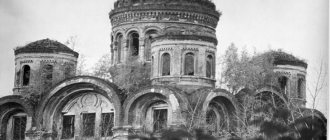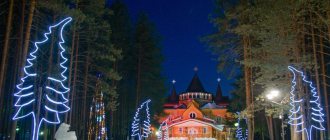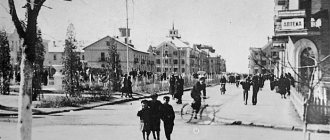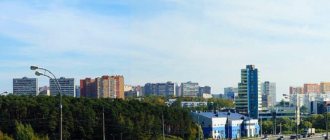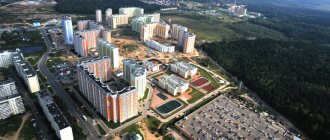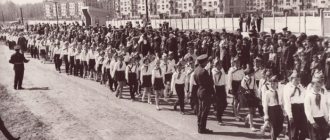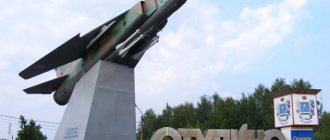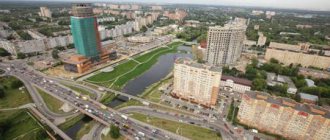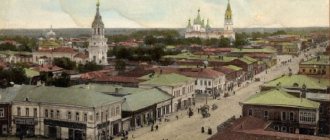Geography
The village of Bronnitsy station is located in the eastern part of the Ramensky district, approximately 9 km southeast of the city of Ramenskoye and 9 km northeast of the city of Bronnitsy. The Dorka River flows 3 km north of the village. The height above sea level is 123 m[2].
There are three streets in the village - Krasnoarmeyskaya, Lesnaya, Mira; eight horticultural non-profit partnerships (SNT) are assigned (Aeroflot, Brotex, Druzhba, Paluba, Radist, Sadovoe, Torfyanik, Energia-2) and one garage-building cooperative ( GSK) (“Friendship”)[3].
The nearest settlements are the villages of Druzhba, Mirny, the villages of Yurovo, Kuznetsovo and the village of Malyshevo.
- Unfinished house
- Shop
Moscow-Ryazan Railway
Story
In 1862, the Bronnitsy railway station was opened on the Ryazan direction of the Moscow Railway, named after the neighboring city of Bronnitsy, which it served. Subsequently, a village of the same name was formed at the station[4].
In 1926, the village was part of the Malyshevsky village council of the Zagornovsky volost of the Bronnitsky district of the Moscow province of the RSFSR[5].
Since 1929, it has been a populated area within the Ramensky district of the Moscow district of the Moscow region[6].
From 1994 until the municipal reform of 2006, the village was part of the Yurovsky rural district of the Ramensky district[7].
From 2006 to 2022 was part of the rural settlement of Kuznetsovskoye, Ramensky district[8].
ARMORS
BRONNITSY, a city in Russia, in the central part of the Moscow region, the center of the urban district of the same name. Population 22.5 thousand people. (2019). Located on the high left bank of the river. Moscow (pier), 11 km from the railway station of the same name.
Story
First mentioned in 1453 as s. Bronnichi in the spiritual letter of the Grand Duchess of Moscow Sofia Vitovtovna, wife of Vasily I Dmitrievich. The name, according to legend, is due to the fact that armor masters lived here, making armor and chain mail. According to another version, the name means a place of frequent battles (“battles”) with the Mongol-Tatars. Apparently, already from the 16th century. was the royal estate. There was a royal stud farm in Bronnitsy (no later than 1634–1845); in 1706 Peter I transferred it, along with the assigned peasants, to the personal possession of the prince. A.D. Menshikov, by decree of Emperor Peter II in 1728, the plant was again transferred to the department of the palace Stables department. In 1781–1924 Bronnitsy was a district town in the Moscow province. The economic activities of the population were associated with meeting local demand and servicing the Moscow-Kolomna trade route. In 1929–59 the regional center of the Moscow region (in 1959–60 as part of the Lyubertsy district, in 1960–92 – in the Ramensky district). Since 1992, it has been a city of regional subordination, the center of the urban district of the same name.
Architecture
Photo by A. I. Nagaev Bronnitsa. Cathedral of the Archangel Michael (1696–1705) and the bell tower (mid-19th century) in the central square of the city.
The regular layout of the 18th century has been preserved in Bronnitsy. with a rectangular street network. To the center. square - the 5-domed pillarless Cathedral of the Archangel Michael (1696–1705) with a refectory (rebuilt in 1865), combining the type of a posad church with the decorative elements of Moscow. Baroque (in the interior, stucco cartouches are framed by picturesque panels; icons by T. I. Filatiev were transferred to the Museum of Ancient Russian Art named after St. Andrei Rublev); classic the Church of St. John the Merciful (Entry of Jerusalem; early 1840s, architect A. M. Shestakov) and the bell tower (mid-19th century, architect V. I. Bove). The complex of barracks for the cavalry regiment, forming a square with corner and entrance pavilions, was built in the Empire style (1st half of the 19th century). In 1999, a memorial park was created on the site of the demolished cemetery, the tombstone of A. S. Pushkin’s grandson, A. A. Pushkin (1863–1916), who served as the leader of the Bronnitsy district zemstvo government (1894–1916), and the Bronnitsy district leader of the nobility (1896–1909), was restored ). His bust (sculptor M. G. Salman) was installed in the same year in front of the city administration building.
Centers of science and culture
Research Institute of Automotive Technology No. 21 of the Ministry of Defense of the Russian Federation. Branch of the Moscow Automobile and Highway Institute. Museum of City History (1998).
Farm
Jewelry production (the largest enterprise in the city is Bronnitsky Jeweler), woodworking, light and food industries.
Neighborhood
Near the city, in the village. Markovo (in the 17th century, the patrimony of the Odoevsky princes), - Kazan Church (1672–80, architect, possibly P. P. Potekhin), single-domed, surrounded on 3 sides by covered porches, decorated with tiles and white stone carvings (later rebuilt, decoration the interior was made by masters of the Armory Chamber; the iconostasis with icons from the 1st half of the 18th century; the chapel iconostasis - in the Museum of Ancient Russian Art named after St. Andrei Rublev). In the village Krivtsy (at the beginning of the 18th century, the possession of Prince M.A. Volkonsky) - Smolensk Church (1708) in the Moscow Baroque style, of the “octagon on a quadrangle” type, with white stone carved decoration, carved iconostasis (beginning of the 18th century, with renovations in the 19th and 20th centuries). Near the city there are the estates Denezhnikovo in the style of classicism (created in the last quarter of the 18th century by the owner I.L. Talyzin and his heirs) and Avdotino (the estate of the enlightener N.I. Novikov). The Decembrists M.A. Fonvizin (1853–54) and I.I. Pushchin (1857–59) lived in the Maryino estate; both were buried in Bronnitsy near the walls of the Cathedral of the Archangel Michael.
Notes
- ↑ 1 2 3
The size of the rural population and its distribution in the Moscow region (results of the 2010 All-Russian Population Census).
Volume III (undefined)
(DOC+RAR). M.: Territorial body of the Federal State Statistics Service for the Moscow Region (2013). Retrieved October 20, 2013. Archived October 20, 2013. - Bronnitsy station village (Ramensky district). Photo Planet (undefined)
. Access date: May 19, 2015. - Classifier of addresses of the Russian Federation (undefined)
. State register of addresses of the Federal Tax Service of Russia. Access date: May 19, 2015. - Pospelov E. M.
Geographical names of the Moscow region: toponymic dictionary: more than 3500 units. - M.: AST: Astrel, 2008. - P. 171. - 3000 copies. — ISBN 978-5-17-042560-0. - ↑ 12
Directory of populated areas of the Moscow province (Based on materials of the All-Union Census of 1926). — Moscow statistical department. - M., 1929. - P. 64-65. — 2000 copies. - Handbook on the administrative-territorial division of the Moscow region 1929-2004. - M.: Kuchkovo Pole, 2011. - 896 p. — 1500 copies. — ISBN 978-5-9950-0105-8.
- Law of the Moscow Region of February 25, 2005 No. 55/2005-OZ “On the status and boundaries of the Ramensky municipal district and newly formed municipalities within it” ( original version
)
(unspecified)
. Access date: February 7, 2015. - Law of the Moscow Region dated February 25, 2005 No. 55/2005-OZ “On the status and boundaries of the Ramensky municipal district and newly formed municipalities within it” (undefined)
. Access date: February 7, 2015. - Directory of populated areas of the Moscow province. — Moscow statistical department. - M., 1929. - 2000 copies.
- ↑ 1 2 Koryakov Yu. B.
Ethno-linguistic composition of settlements in Russia: [arch. November 17, 2020]: database. — 2016.
Bronnitsy
The predecessor of the modern city of Bronnitsy was the village of Bronniche. There are different versions about the origin of the name of the village. According to one version, armor masters lived in it. Others associate the name with the ford that existed here across the Moscow River (Brodnichi), with the sites of ancient battles - “battles”. The ending "che" usually indicates the owner of the village. It is likely that in this case the name of the village could be associated with a feudal lord named Bronislav or the nickname “armornik”, i.e. the owner of heavy military armor. The history of the city of Bronnitsy dates back to the second mid-15th century. The first written mention of the village of Bronniche dates back to this period, when the wife of the Great Moscow Prince Vasily Dmitrievich (son of Dmitry Donskoy) Sofya Vitovtovna in 1453 bequeathed it, among other villages and volosts, to her grandson Yuri Vasilyevich - Prince Dmitrovsky. At the same time, it is indicated that the villages of Bronnichi, Krivtsovo and Velino were “purchase”, that is, they were not previously part of the possession of the princely family, but were purchased from another owner.
The princess’s new villages were located on the territory of Kolomna district. They remained part of it until the second half of the 18th century. The location of the village of Bronniche, which was located halfway between Moscow and Kolomna - the largest trading cities of that time, was very convenient. The proximity of the river pier and the ford across the Moskva River that existed at that time, through which the road from Kasimovsky to Kashirsky and Serpukhov highways passed, suggests that the village arose much earlier than what is said about it in official documents.
After 19 years, the childless Prince Yuri bequeathed the village in 1472 as a gift to the Pafnutiev Monastery in Borovsk (now a city in the Kaluga region). The village was surrounded by villages and was the center of the area. The will listed the lands used by the peasants and mentioned the Moskvorets meadows. For a long time, hay from them was exported in large quantities along the river, and in winter, by sleigh ride to Moscow, it was sold on the spot to cab drivers passing through the village, heading towards Moscow and towards Kolomna. Prince Yuri frees the peasants from half the debt, without payment of which they could not leave the estate of their high owner.
Large villages gradually emerged along the trade routes, where horse feed was traded, overnight accommodations were arranged for travelers, and carts and harnesses were repaired. On the Kolomenskaya road, Bronniche, Borsheva, Stanovoe, Ostrovtsy became such people. Subsequently, the village of Bronniche began to play a noticeable role in the district and surpassed the village of Borsheva, located four miles to the south, which was considered the center of an important palace volost in Kolomensky district.
The development of Rus' was delayed by two centuries of its dependence on Mongol-Tatar oppression. The path to the southeastern steppe ran through Bronnitsy, from where foreigners invaded more than once. In 1380, part of the troops of Dmitry Donskoy passed here under the leadership of Prince Vladimir Andreevich Serpukhovsky, and 2 years after the Battle of Kulikovo, the army of Tokhtamysh broke through here, plundering Moscow and its environs and extending the payment of tribute to the Tatars for another century. In the 15th century, raids on Moscow were repeated more than once, including along the Kolomenskaya Road. Only after “standing on the Ugra” in 1480, when the Tatars did not dare to engage in battle with the army of the strengthened Moscow prince Ivan III and retreated, Rus' stopped paying them tribute and gained freedom.
In the middle of the 16th century, the army of Ivan the Terrible passed through Bronnitsy and Kolomna to Kazan. At the beginning of the 17th century, during the “Time of Troubles,” detachments of the peasant army of Ivan Bolotnikov passed through here. In 1608-1610, battles were fought with Polish troops. During these years, many villages and hamlets, devastated by the war, disappeared in the region.
Under Tsar Mikhail Romanov (1613-1645), many palace lands were transferred to his entourage. In order to strengthen the equestrian army, a number of royal estates were transformed into palace stables. The village of Bronnichi was among them. Here, surrounded by vast meadows, the “sovereign mare’s stable” was located in 1634, turned into a large stud farm, where horses were kept and prepared for trips of the royal family. The stable contained horses of rare breeds, often donated by the rulers of other countries to the Russian sovereigns.
The population of the village and neighboring palace estates was engaged in servicing the horses, growing fodder for them and harvesting hay. Residents of the villages of Bronnitsy and Velino were entirely occupied with servicing the stud farm. Thus, Bronnitsy, with the exception of two decades when Peter I transferred them to Prince A.D. Menshikov for personal ownership, belonged to the royal family.
During the Pugachev uprising, as it approached central Russia, the residents of Bronnitsy sympathized with the rebels. On August 4, 1774, the Senate listened to the report of the Palace Stables Chancellery on the refusal of the peasants to give the required two people from every hundred souls to the established military corps. But the resistance of the peasants was broken. After 2 days, 22 people were sent to the newly formed corps. This fact speaks of the disobedience of Bronnitsy residents to the authorities.
At the end of the 18th century, frightened by the scale of the peasant war, Catherine II carried out a provincial administrative reform, according to which the village of Bronnitsy in 1782 received the status of a district town and the center of the Bronnitsky district, formed at the expense of the separated volosts of the southern part of the Moscow and northern parts of the Kolomensky district. In the new district, approximately one third of the population were state, palace peasants. There were up to 80 thousand dessiatines of arable land in the new district, more than 20 thousand dessiatines of mowing, over 86 thousand dessiatines of forests, more than 209 thousand in total. After the liquidation of the neighboring Nikitsky district in 1801, most of its villages moved to Bronnitsky - Bykovo, Ostrovtsy, Myachkovo, Konstantinovo, Zhiroshkino, Nikonovskoye, etc. In this form, the district remained almost unchanged until 1929, when the reorganization of provinces, districts and volosts in regions and districts. The main occupations of the peasants were arable farming, cattle breeding, vegetable gardening, horticulture, trade and crafts. They worked as carriers, delivering hay, firewood, and bread to the capital. They kept inns where cabbies and merchants passing by stopped.
At its foundation, the newly established city of Bronnitsy differed little from an ordinary large village. According to economic notes compiled based on information from the 1760s, it consisted of “639 merchants, townspeople and residents of various ranks, 126 dessiatines of land under the village, 677 dessiatines of arable land, 52 dessiatines of hayfields, 8 dessiatines of forest, inconvenient places (under roads and lake) 44 dessiatines, ... the village is located near Lake Belskoye and on the shore of an unnamed ravine. In that city there are 2 churches: 1st Archangel Michael, 2nd John the Merciful with a stone fence and storeroom. Two courtyards: a stone state-owned factory, in which there are horses... Spanish, German, Polish; wooden courtyard. The inhabitants of that city do not have trade and earn their living by arable farming. Women practice household handicrafts."
However, after just a few years, both the composition of the population and the appearance of the county town change. Houses of public places appeared: the “mayor’s” administration, the district court and the district treasury, the number of officials and nobles who moved to the city grew. The merchant class is increasing, which is replenished by rich peasants from different villages. Already in 1787, according to the book “Historical and Topographical Description of the Cities of the Moscow Province,” compiled by Moscow University professor Kh. A. Chebotarev, in the city of Bronnitsy there were 223 houses and 1,542 inhabitants.
The coat of arms of the new city, made by the palace king of arms, was a vertical rectangle. On the upper half, on a red background, St. George the Victorious was depicted on a horse, slaying the serpent, as on all the coats of arms of the cities of the Moscow province, and in the lower part the coat of arms of the Bronnitsy themselves was a golden horse on a green field. At the same time it is said: “The golden horse is a sign that there were glorious horse studs in this place.”
The city was built up in accordance with the highest approved plan in the form of a regular quadrangle 600 fathoms long and 400 wide, divided into even blocks, where all the streets were located at right angles. An elementary school and a school for the children of stable employees appeared in the city. In the city there were 3 forges and 21 shops where they sold red tape, scarves, and lace products made in Moscow.
The territory of the city was divided into two parts by the Kolomenskaya Road. Near the Church of the Archangel Michael, a center with stone one- and two-story houses gradually took shape, followed by the houses of officials, and on the outskirts - the houses of peasants and artisans. Shops, shops and warehouses were usually built in merchant stone houses. Wine and salt shops were built. Next to the cathedral in the 40s of the 19th century, the provincial architect A. Shestakov built the Jerusalem Church - a one-story building topped with a dome on a small light drum, with four-column porticoes of the Tuscan order placed on three sides.
By the beginning of the 19th century, there were 63 merchant houses in Bronnitsy. Almost a quarter of local families belonged to the merchant rank. According to the number of merchants from 14 cities of the province, after Serpukhov, Kolomna and Vereya, Bronnitsy took fourth place, ahead of a city such as Dmitrov. According to the declared capital of 64 thousand rubles, Bronnitsy took fifth place in the province. Merchants bought livestock from traders from the southern districts and from surrounding peasants and sold them at bazaars and fairs in Moscow and other cities and large villages.
Among the artisans were tailors, blacksmiths, cart makers, and shoe felters. Children were often sent to Moscow for training, including learning how to print designs on fabric and make silver and copper items. Since the 19th century, jewelry production has also expanded. The population increased rapidly.
The auxiliary transit function of Bronnitsy to provide Moscow with industrial raw materials and food was later sharply reduced due to the construction of the Moscow-Ryazan railway in 1862. The distance from the railway became a brake on the development of the city. Bronnitsy merchants and residents collected five thousand silver rubles for the construction of the Bronnitsy railway station on the Moscow-Ryazan road and a 12-verst access road from the city to the station. The station was opened in 1868, which made it possible to improve communications with Moscow and the markets of other cities. And yet, this remoteness constantly affected the development of the city: in 1924, about 3.5 thousand people lived in it, there was not a single large industry.
As you enter the city from Moscow, there is a prominent red building with white decor – the Church of Elijah the Prophet, built in the 1870s and currently being restored. The tall building with large windows framed by white frames and a wide frieze along the top is distinguished by exquisite proportions. Near the church there was an ancient cemetery, where in 1916 the grandson of A.S. Pushkin, Alexander Alexandrovich, was buried, who lived in the city for many years, and from the 1890s was the zemstvo chief, then the chairman of the Bronnitsy district duma, and was elected leader of the district council for many years. nobility. Showing daily care and attention to the local residents and peasants of the county, he was especially concerned about the development of education and health care, including largely contributing to the construction of two gymnasiums and a hospital in the city. In 1916, the newly built hospital became a hospital for those wounded on the fronts of the First World War. The soldiers who died there were buried in the old cemetery, where in recent years a pyramid monument to Russian soldiers was restored on their mass grave.
In the very center of the city is the Cathedral of the Archangel Michael, built in 1696–1705, the appearance of which combines the three-dimensional composition of posad churches of the 17th century and decorative elements of the Moscow Baroque of late times. Near the altar are the graves of the Decembrists - Ivan Ivanovich Pushchin, Mikhail Alexandrovich and Ivan Alexandrovich Fonvizin.
The city also preserves the buildings of the cavalry regiment barracks, built more than a century ago in the Empire style.
Reservoirs are an adornment of the city landscape and a place of recreation for citizens, and in the southern part of the city, where the river approaches its streets, in the summer there is a pier for tourist ships and a beach for citizens.
At different times, V. G. Belinsky, F. M. Dostoevsky, N. V. Gogol, I. I. Lazhechnikov, N. D. Ivanchin-Pisarev, S. F. Durov, N. P. Ogarev, visited Bronnitsy D. V. Grigorovich, N. I. Nadezhdin, A. I. Koshelev, M. M. Prishvin, Albert Rees Williams and many others.
Industrial enterprises of the city were transformed into joint-stock companies. They produce a wide variety of products: jewelry, clothing, typewriters, suitcases, knitted mittens, gloves and much more. The city bus station connects the city with many adjacent villages and hamlets, as well as with Moscow and the Bronnitsy railway station.
In 1992, the city of Bronnitsy received the status of a city of regional subordination, but retained close ties with the Ramensky district. Since 1967, the name of the city of Bronnitsy has been enshrined in the names of Bronnitskaya Street and Bronnitsky Lane in Moscow.
The article uses materials from the book by M. G. Averyanova “Encyclopedia of villages and hamlets of the Moscow region. Ramensky region.
Links
- Official website of the rural settlement of Kuznetsovskoye (unspecified)
(inaccessible link). // Kuznetsovskoe.rf. Archived from the original on May 18, 2015. - The village of Bronnitsy station on the topographic map of the Moscow region (2005 map) (unspecified)
. //etomesto.ru.
| Populated areas of Ramensky urban district | |
District center Ramenskoye
| |
